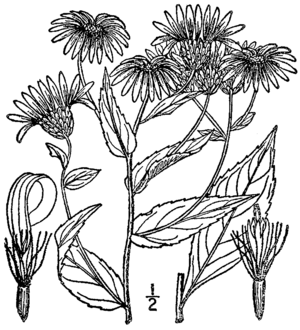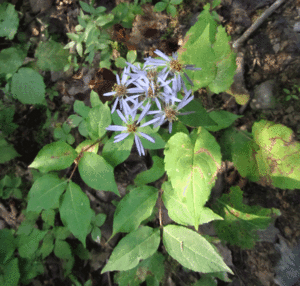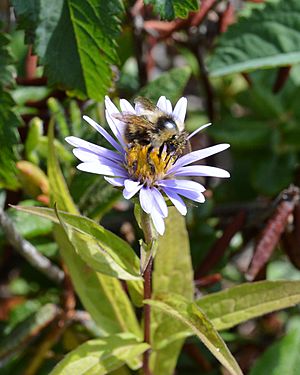Low rough aster facts for kids
Quick facts for kids Low rough aster |
|
|---|---|
 |
|
| Conservation status | |
| Scientific classification | |
| Genus: |
Eurybia
|
| Species: |
radula
|
| Synonyms | |
|
|
The low rough aster (scientific name: Eurybia radula) is a wild plant that grows year after year. It is also known as the rough wood aster. This plant is part of the aster family, which includes many well-known flowers like sunflowers and daisies.
You can find the low rough aster in eastern North America. It grows from Newfoundland and Labrador in Canada, all the way west to Ontario. In the United States, it grows south to Kentucky and Virginia. It is also found on the small French islands of St. Pierre and Miquelon, near Newfoundland.
This plant loves wet places. It grows in many different wet areas, like bogs (wet, spongy ground) and fens (another type of wetland). You can also spot it along creek shores and in ditches. The low rough aster usually blooms in late summer or early fall. Its flowers have pale blue-violet petals (called rays) and bright yellow centers.
Where the Low Rough Aster Lives
The low rough aster is found across many parts of eastern North America. In Canada, it grows in every province east of Ontario, including Ontario itself. It also lives on the French territory of St. Pierre and Miquelon. Its most northern spot in Canada is in northeastern Ontario, near James Bay.
In the United States, you can find this plant from Maine down to Kentucky and Virginia. However, it does not grow in Ohio or states further west. Even though it's common in many places, the low rough aster is considered endangered or at risk in some U.S. states. These include Connecticut, Kentucky, Maryland, New Jersey, and New York.
What Kind of Places It Likes
The low rough aster grows best in wet soil. It can live in many different kinds of wet places. This includes very wet areas like fens and sphagnum bogs, which can have different pH levels (how acidic or basic the soil is).
You might also see it on the edges of lakes and creeks, in wet meadows, and even in ditches. While the plant doesn't like deep shade, it can grow in open, wet forests. These forests often have spruce trees and tamarack larch trees. You can find the low rough aster from sea level up to more than 600 meters (about 2,000 feet) high.




